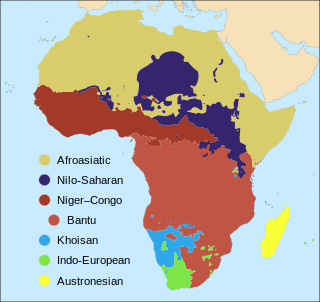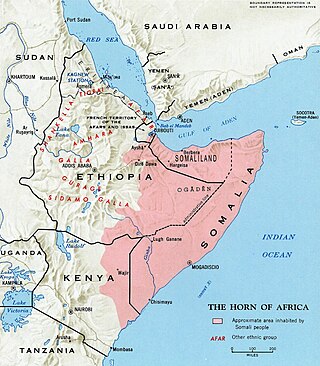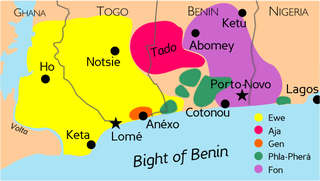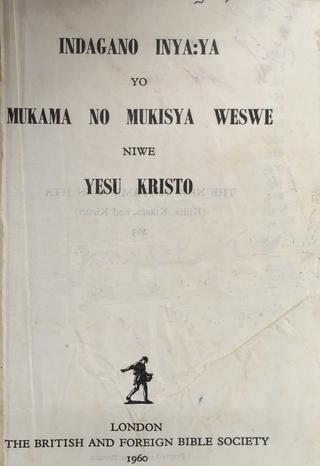
Swahili, also known by its local name Kiswahili, is a Bantu language originally spoken by the Swahili people, who are found primarily in Tanzania, Kenya and Mozambique. The number of current Swahili speakers, be they native or second-language speakers, is estimated to be over 200 million, with Tanzania known to have most of the native speakers.

The number of languages natively spoken in Africa is variously estimated at between 1,250 and 2,100, and by some counts at over 3,000. Nigeria alone has over 500 languages, one of the greatest concentrations of linguistic diversity in the world. The languages of Africa belong to many distinct language families, among which the largest are:

Kirundi, also known as Rundi, is a Bantu language and the national language of Burundi. It is a dialect of Rwanda-Rundi dialect continuum that is also spoken in Rwanda and adjacent parts of Tanzania, the Democratic Republic of the Congo, Uganda, as well as in Kenya. Kirundi is mutually intelligible with Kinyarwanda, the national language of Rwanda, and the two form parts of the wider dialect continuum known as Rwanda-Rundi.

Somali is an Afroasiatic language belonging to the Cushitic branch. It is spoken as a mother tongue by Somalis in Greater Somalia and the Somali diaspora. Somali is an official language in Somalia and Ethiopia, and a national language in Djibouti as well as in northeastern Kenya. The Somali language is written officially with the Latin alphabet although the Arabic alphabet and several Somali scripts like Osmanya, Kaddare and the Borama script are informally used.

Ewe is a language spoken by approximately 5 million people in West Africa, mainly in Ghana and Togo. Ewe is part of a group of related languages commonly called the Gbe languages. The other major Gbe language is Fon, which is mainly spoken in Benin. Like many African languages, Ewe is tonal as well as a possible member of the Niger-Congo family.
The Gusii language is a Bantu language spoken in Kisii and Nyamira counties in Nyanza Kenya, whose headquarters is Kisii Town,. It is spoken natively by 2.2 million people, mostly among the Abagusii. Ekegusii has only two dialects: The Rogoro (upper-side) and Maate (lower-side) dialects. Phonologically, they differ in the articulation of /t/. Most of the variations existing between the two dialects are lexical. The two dialects can refer to the same object or thing using different terms. An example of this is the word for cat. While one dialect calls a cat ekemoni, the other calls it ekebusi . Another illustrating example can be found in the word for sandals. While the Rogoro word for sandals is chisiripasi , the Maate dialect word is chitaratara . Many more lexical differences manifest in the language. The Maate dialect is spoken in Tabaka and Bogirango. Most of the other regions use the Rogoro dialect, which is also the standard dialect of Ekegusii.

Makhuwa is the primary Bantu language of northern Mozambique. It is spoken by four million Makua people, who live north of the Zambezi River, particularly in Nampula Province, which is virtually entirely ethnically Makua. It is the most widely spoken indigenous language of Mozambique.
Luhya is a Bantu language of western Kenya.
Phuthi (Síphùthì) is a Nguni Bantu language spoken in southern Lesotho and areas in South Africa adjacent to the same border. The closest substantial living relative of Phuthi is Swati, spoken in Eswatini and the Mpumalanga province of South Africa. Although there is no contemporary sociocultural or political contact, Phuthi is linguistically part of a historic dialect continuum with Swati. Phuthi is heavily influenced by the surrounding Sesotho and Xhosa languages, but retains a distinct core of lexicon and grammar not found in either Xhosa or Sesotho, and found only partly in Swati to the north.
Basaa, or Mbene, is a Bantu language spoken in Cameroon by the Basaa people. It is spoken by about 300,000 people in the Centre and Littoral regions.
The Somali Bantus are a Bantu ethnic minority group in Somalia who primarily reside in the southern part of the country, primarily near the Jubba and Shabelle rivers.

The Ekoid languages are a dialect cluster of Southern Bantoid languages spoken principally in southeastern Nigeria and in adjacent regions of Cameroon. They have long been associated with the Bantu languages, without their status being precisely defined. Crabb (1969) remains the major monograph on these languages, although regrettably, Part II, which was to contain grammatical analyses, was never published. Crabb also reviews the literature on Ekoid up to the date of publication.
Yao is a Bantu language in Africa with approximately two million speakers in Malawi, and half a million each in Tanzania and Mozambique. There are also some speakers in Zambia. In Malawi, the main dialect is Mangochi, mostly spoken around Lake Malawi. In Mozambique, the main dialects are Makale and Massaninga. The language has also gone by several other names in English, including chiYao or ciYao, Achawa, Adsawa, Adsoa, Ajawa, Ayawa, Ayo, Ayao, Djao, Haiao, Hiao, Hyao, Jao, Veiao, and waJao.
The Somali languages form a group that are part of the Afro-Asiatic language family. They are spoken as a mother tongue by ethnic Somalis in Horn of Africa and the Somali diaspora. Even with linguistic differences, Somalis collectively view themselves as speaking dialects of a common language.
Tunni is a Somali language spoken by the Tunni who reside in the Lower Shebelle, Middle Juba, Lower Juba and part of Bay regions in southern Somalia. The language is typically classified among the Digil group of Somali languages. Tunni is distinct from Somali, with a different phonology and sentence structure.
Gaam (Gaahmg), also known as Ingessana, (Me/Mun) Tabi, Kamanidi, or Mamedja/Mamidza, is an Eastern Sudanic language spoken by the Ingessana people in the Tabi Hills in Blue Nile State in eastern Sudan, near Ethiopia. It was considered an isolate within Eastern Sudanic until the other Eastern Jebel languages were discovered in the late 20th century. Dialects are Soda (Tao), Kukur (Gor), Kulang, Buwahg (Buek).
Rwanda-Rundi is a group of Bantu languages, specifically a dialect continuum, spoken in Central Africa. Two dialects, Kirundi and Kinyarwanda, have been standardized as the national languages of Burundi and Rwanda respectively. These neighbouring dialects are mutually intelligible, but other dialects which are more distant ones may not be. The other dialects are spoken in the Democratic Republic of the Congo, Uganda, and Tanzania; Ha, with one million speakers, is the most widely spoken.
Taita is a Bantu language spoken in the Taita Hills of Kenya. It is closely related to the Chaga languages of Kenya and Tanzania. The Saghala variety is distinct enough to be considered a language separate from the Daw'ida and Kasigau dialects.

Jita is a Bantu language of Tanzania, spoken on the southeastern shore of Lake Victoria/Nyanza and on the island of Ukerewe.
Nyoro-Tooro is a language spoken by around 1,200,000 people living in western Uganda. It is often defined as two separate languages: Nyoro and Tooro, though it is defined as one language by the Ministry of Education in Uganda. It is closely related to Runyankore-Rukiga.









